Table of Contents
Rock Cut Architecture
This article deals with topic titled ‘Rock Cut Architecture .’ This is part of our series on ‘Culture’ . For more articles , you can click here
Introduction
- There are around 1500 Rock Cut Architectures in India and most of them religious
- Built mainly by Indian sculptures,monks and general public
- Two types of caves (mostly both were present at one site)
| Chaitya | Prayer Hall for Monks |
| Vihara | Residence /Rest place for Monks |
1 . Barabar Caves
- Oldest example of rock cut caves
- Located in Barabar Hills,Bihar
- Caves date back to reign of Ashoka and his son Dasratha
- Initially built for Ajivika sect. Later for all Buddhists, Jain & Brahmanical traditions
Main caves at Barabar
| Lomas Rishi Cave | – Known for horse shoe type façade – It imitate contemporary timber architecture of that time – Polished from inside is it’s marked feature |
| Sudama Cave | – Known for bow shaped arch – This and Lomas Rishi cave are the oldest rock cut caves |
| Karan Chaupar | – Single rectangular room with polished surfaces – Contains inscription dating back to Mauryan era |
| Visva Zopri | There are two rectangular caves there |
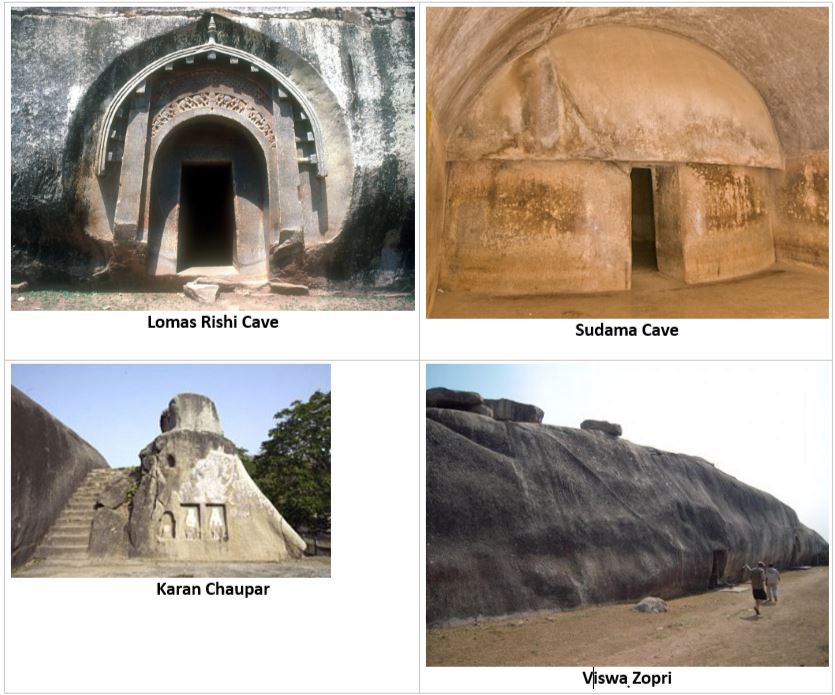
2. Kanheri Caves
- Location- Kanheri, north of Borivali Mumbai within Sanjay Gandhi National Park
- Early caves excavated in 1st & 2nd century BC
- Caves continuously occupied by Buddhist monks & inland traders as stop till 7th century AD
- Have both Chaityas & Viharas
- It’s Chaitya is the 2nd largest Chaitya after Karle Caves
Significance of these caves
- Site provides view of development of Buddhist art for a thousand years from 1st century BC as its proximity to sea & thriving ports ensured continual patronage by mercantile class
- Kanheri temple presents last expression of early rock cut tradition of western India
- These are home to colossal Buddha statue and mark the beginning of long tradition of colossal Buddha which became popular in Tibetan & central asia

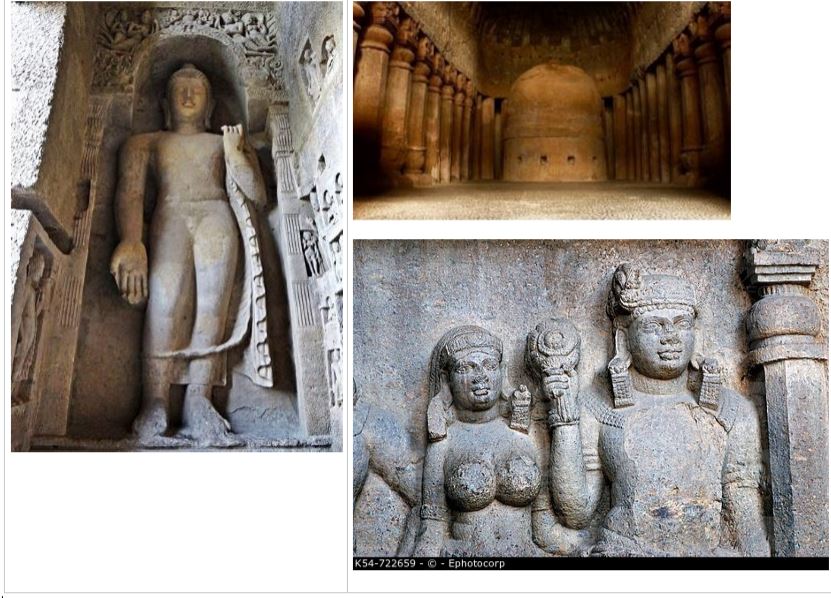
3. Karle Caves
- Location – near Lonavala,Maharashtra(between Mumbai & Pune)
- Shrines developed over two periods
| First Phase | 2century BC to 2century AD |
| Second Phase | 5century to 10th century AD |
- Caves provided lodging houses to travelling traders thus ensured continued patronage
- Associated with Mahasamghika sect of Buddhism
- Largest rock cut Chaitya in India
- Sculptures include Mithuna and animals such as lions & elephants
- Roof is given shape like that of wood (hence, giving wooden look to stone cut cave was still prevalent)
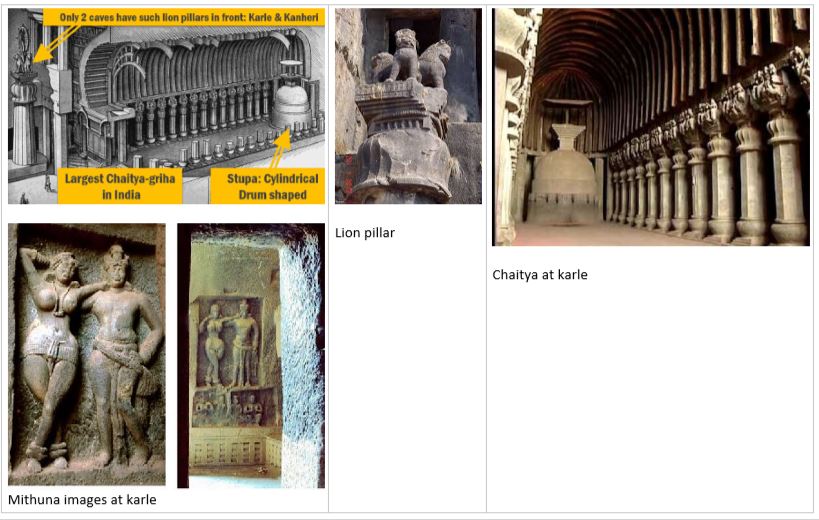
4. Bhaja Caves
- Belongs to Hinayana faith
- It has Wooden ceiling over Chaitya-griha.
- Stupa has a hole on top, for inserting wooden umbrella.

5. Bedsa Caves
- Location -Pune
- Known for chaitya and viharas of 1st century BC
- Chaitya is partly hidden from profane world. Belief was that one should learn truly only when one made a special effort for that purpose
6. Ajanta Caves
- Situation : 100 km from Aurangabad in horse shape gorge of Waghora river
- These caves are carved on a perpendicular cliff. As they are on perpendicular side, there are no courtyards
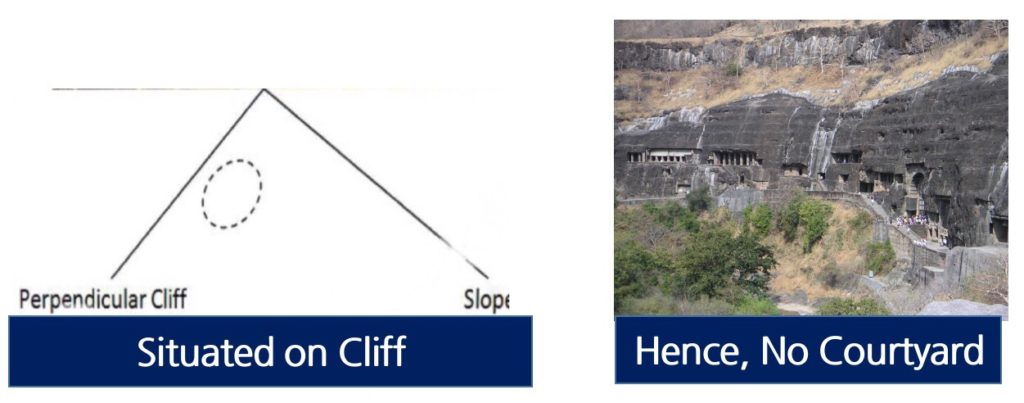
- All the three forms of Art are combined in these caves : Architecture, Sculpture, Paintings
- Were discovered in 19th century (1829)
- Total 29 caves(according to NCERT) : Made in two phases
- These all caves are Buddhist in theme
- 4 Chaityas & 25 Viharas
| Satavahana Phase | – Built in 2nd century BC – Patronage of Satavahana Kings – Hinayana phase ie Buddha represented figuratively – Less figurative sculpture & emphasising on stupa instead |
| Vakataka Phase | – Period:5th & 6th century AD – Patronage:Vakataka Kings – Mahayana phase ie Buddha depicted as human – Human representations of Buddha found in both facades and interior – Murals present in this period which is great artistic achievement |
- Chinese Buddhist traveller Fa-Hien & Huen Tsang refer to Ajanta in their accounts
- 5 Caves belong to Hinayana & 24 to Mahayana
- Chaitya caves – earlier phase : Cave Nos. 10 and 9 and later phase : Cave Nos. 19 & 26. Cave no 19 & 26 are profusely decorated.
Notable paintings and sculptures at Ajanta
- Figures in these caves are painted with considerable naturalism and there is no over -stylisation
- It may also be observed that various skin colours are used in the paintings such as brown, yellowish brown, greenish, yellow ochre, etc. which represent a multicoloured population.
- Paintings of Cave Nos. 16 and 17 have precise and elegant painterly quality. They do not bear the ponderous volume of the sculptures in the caves.
Cave 1
- Consists of a hall sided by 14 cell
- Famous Paintings of Vajrapani and Padmapani situated here (many times asked in UPSC)

Cave 16
- According to an inscription found here, the excavation of this cave was caused by Varahadeva, the minister of Vakataka king Harishena
- Largest and most finest and interesting monastery (vihara ) of all Ajanta caves
- Consist of Colossal hall ,ornate doors ,beautifully painted galleries ,ornamental pillars. Central hall is surrounded by 14 cells on three sides and sanctum housing buddha image as shown in Pralambapadasana
- The important painted themes depicted are the conversion of Nanda; Miracle of Sravasti; Maya’s dream; and certain incidents from the life of Buddha. The Jataka stories depicted are Hasti, Maha-ummagga, Maha-sutasoma.
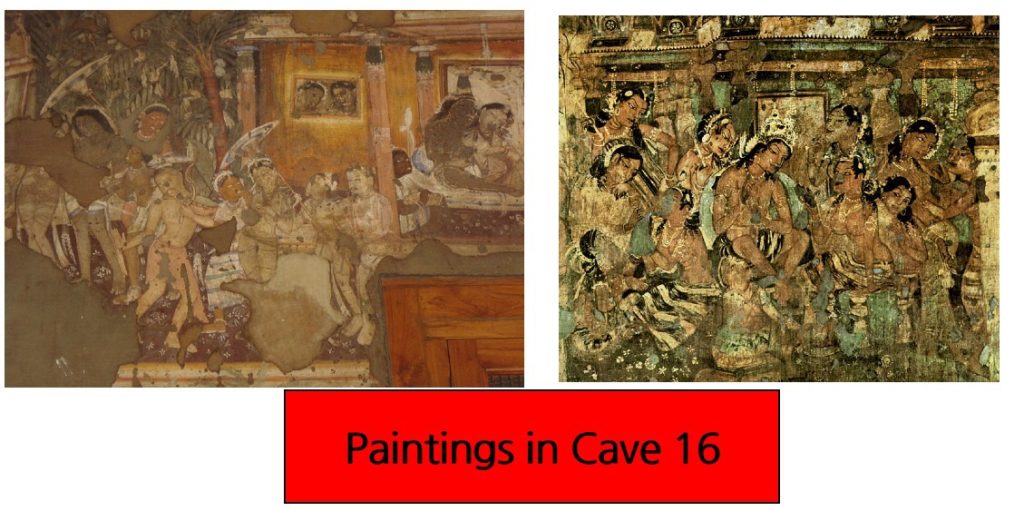
Cave 17
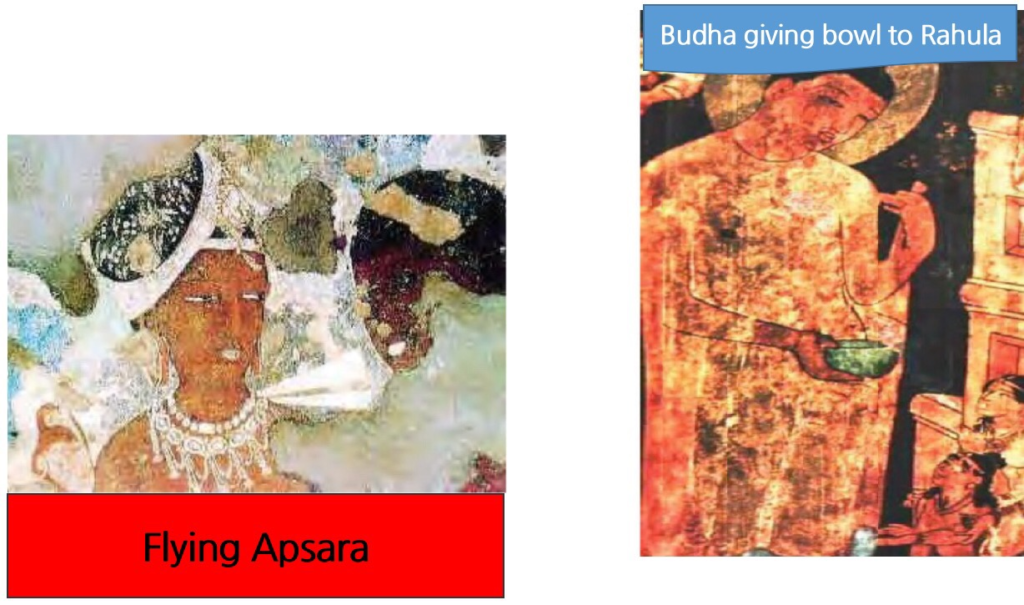
Cave 19
- It is chaitya & most perfect specimen of buddhist art in India
- Built during 5th century AD
- Total 17 pillars in chaitya with single door entry & at centre stands globular buddha
- Other sculpture Buddha offer begging bowl to his son Rahula

7. Ellora Caves
- Location :Aurangabad district in Maharashtra( 100 km from Ajanta )
- Built by: Rashtrakutas (5th to 12thcentury)
- Epitome of Indian rock cut architecture and one of World Heritage sites
- Unlike the Ajanta caves,Ellora cave temples were carved out on the sloping side of the hill. Hence most of the temples have courtyards.
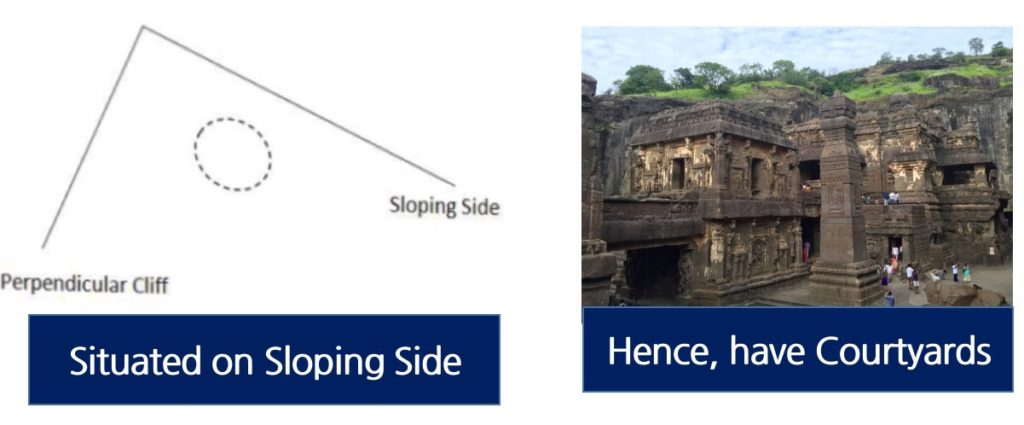
- Ellora has even 3 storey buildings but Ajanta double storeyed only
- Was on trade route from Paithan to Ujjain in central India
- Total : 34 caves (dominant Hindu caves)
| Buddhist | 12 (mainly Vajrayana) | 1-12 |
| Hindu | 17 | 13-29 |
| Jaina | 5 | 30-34 |
Demonstrate generous attitude of rulers towards worshipers of all divinities
Important Caves and Temples within Ellora
Carpenters Cave /Vishvakarma Cave at Ellora : Cave no 10
- Only Chaitya in Ellora rest all are viharas
- Locally known as Vishwakarma ie “celestial architect” or Sutar ka jhopda ie “carpenter’s hut”
- Sculptors have tried to give wooden look to stones
- It is cave no 10 and most famous Buddhist cave at Ellora
- Chaitya hall has stupa on the face of which is a colossal Budha – 3.30 m high & seated in Vyakhyana mudra

Kailasnath Temple : Cave no 16
- Vast multi-storey structure carved inside and outside
- Carved out of single rock
- Built by Rashtrakuta king -Krishna I in 8th century AD
- Remarkable example of Dravidian Architecture
- Vertical excavation- carvers started at the top of original rock and excavated downward.
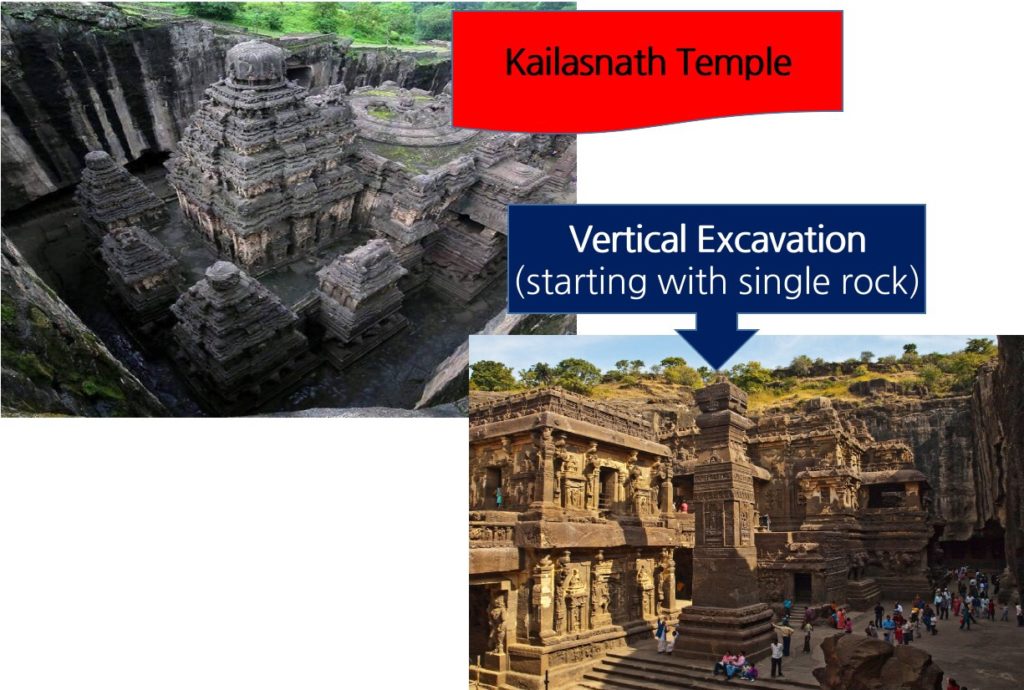
- It has images of deities ,mithunas and other figures.
- Grand sculpture of Ravanna attempting to lift Mt.Kailasa ,abode of Lord Shiva with full might is landmark in Indian art
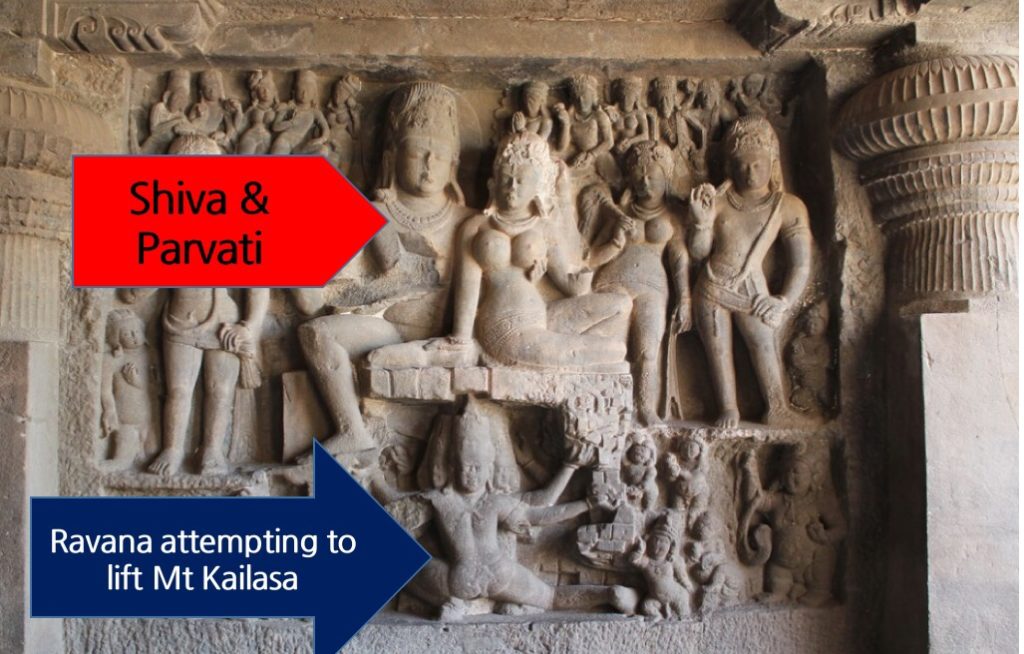
Dashavatara Cave : Cave no 15
- Began as Buddhist cave
- Closely related to Cave 12
- Shows Vishnu in his 10 Avatars
Indra Sabha (Jaina) : Cave no 32
- There are Five Jain caves at Ellora
- Belonging to Digambara sect
Notable ones are:
- Chhota Kailash
- Indra sabha
- Jaganatha sabha
Out of them , Indra sabha is two storeyed cave with one more monolithic shrine in its court
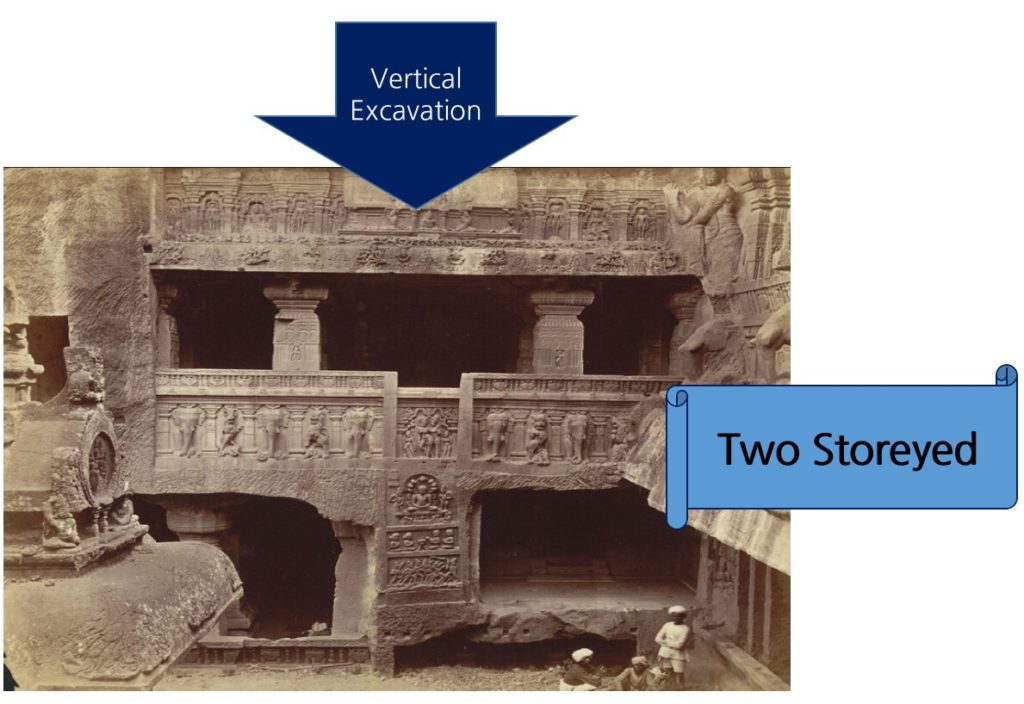
8. Udaigiri Caves
- In Vidisha (there are two Udaigiri Caves, other are Jain Caves in Odisha)
- Developed during reign of Guptas
- Here all the caves (except for one Jaina cave) depict Hindu deities although most of the sculptures are carved outside the caves. These include Four armed standing Vishnu (Cave 6) , Kumara (Cave 3), an eka-mukha linga (Cave 4), pratiharas /Doorkeepers (Cave 6) & Durga Mahishasuramardini( Cave 4,6) .
- A particularly powerful relief shows Vishnu in his boar incarnation rescuing the earth from waters
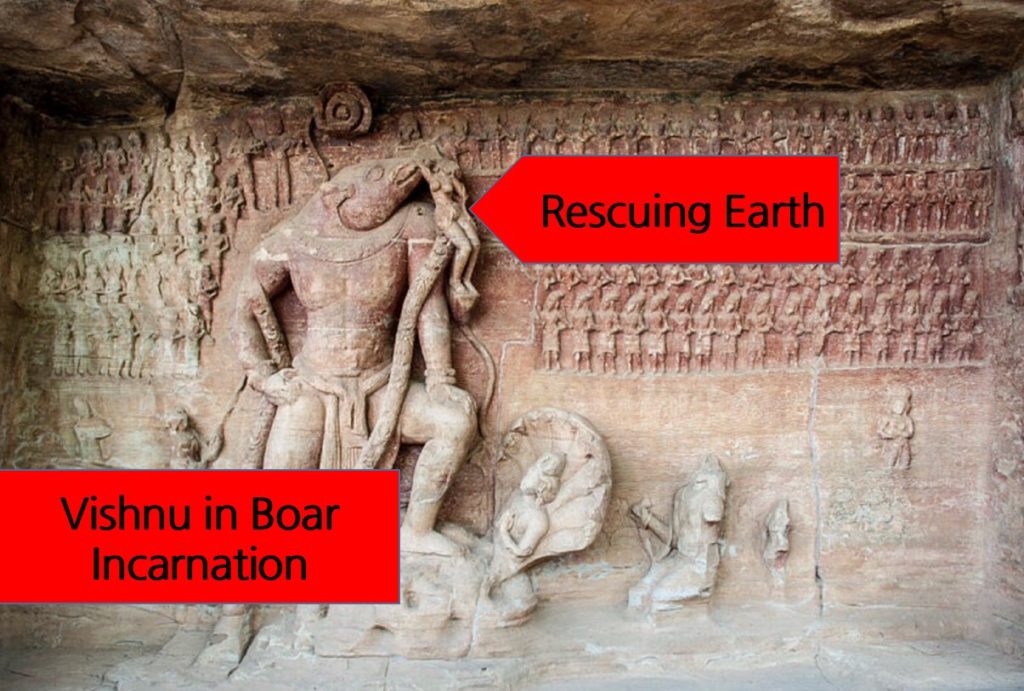
9. Elephanta Caves
- Built under the patronage of Vakataka
- Situated at Elephanta Island in Mumbai Harbour (named so by Portuguese due to presence of Elephants)
- It has two
group of caves
- First Group : 5 Hindu Caves
- Second Group : 2 Hindu Caves
- Hindu caves
are dedicated to Shiva . Central Attraction here is 20 foot statue of 3
headed Shiva . Three heads represent
- Aghori : Aggressive form
- Ardhanarishwara : Half man and half woman
- Mahayogi : Meditative Aspect
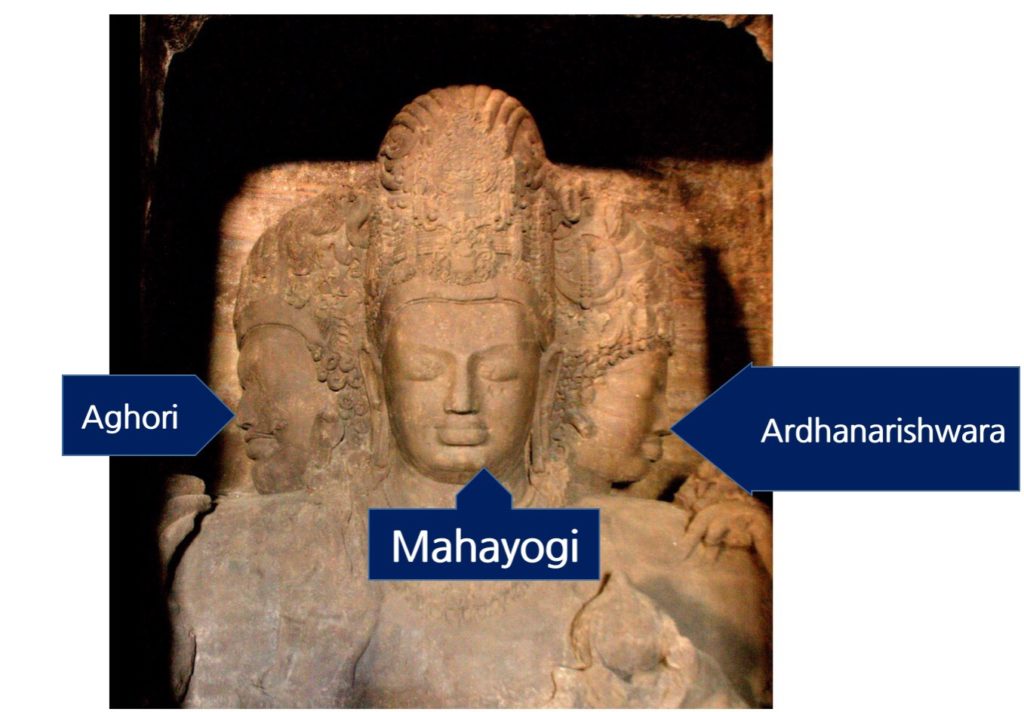
Caves in Eastern Ghats – Udayagiri & Khandagiri
- Udayagiri & Khandagiri hills in Puri District of Orissa 6 km from Bhubaneswar & not far from site of Shishupal Garh
- One of the oldest Jaina rock cut caves are present here
- Sandstone present in these caves are easy to excavate but not very suitable for intricate carving . Stone of these caves are brittle & suffered lot of weathering
- Hathigumpa inscription , carved over an overhanging rock in front of Cave 14 connects it with Mahameghavahana or Chedi Dynasty of Kalinga dated 1st century BC . This dynasty extended patronage to Jainism & hills continued to be occupied by Jaina Ascetics with a few breaks right upto present date

Differences with Buddhist Caves in Western Ghats
- No congregation hall or rock cut shrines present here (in later period although some of the cells were enlarged to make shrines)
- Tiny cells graphically represent hard ascetic regimen of monks who lived here . With few exceptions , they were not high enough to permit man to stand up
- Interior of cell was stark & plain but outer brackets sometimes had carved ornamentation
- Generally single storeyed . Only one is double storeyed ie Ranigumpha (Queens cave) . Ranigumpa is largest & best preserved
